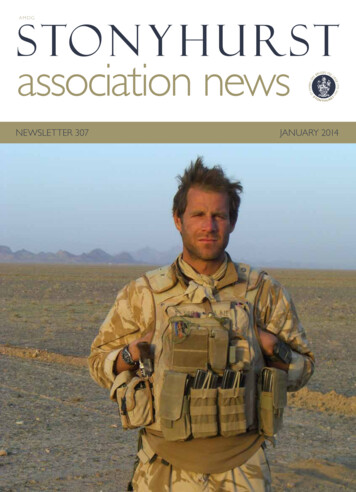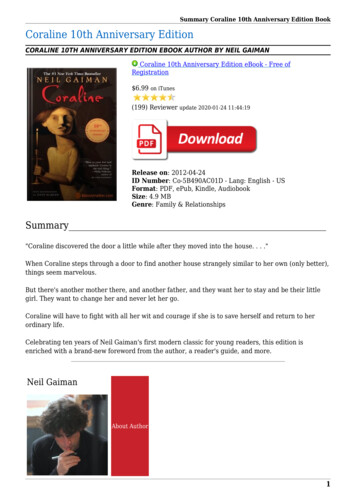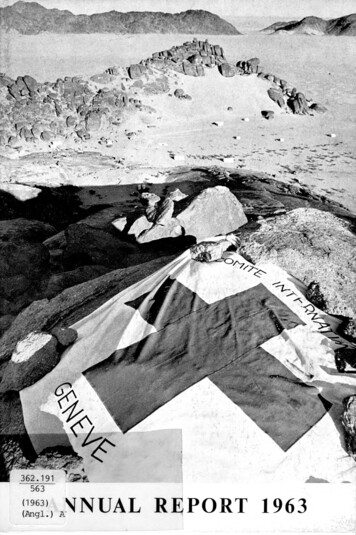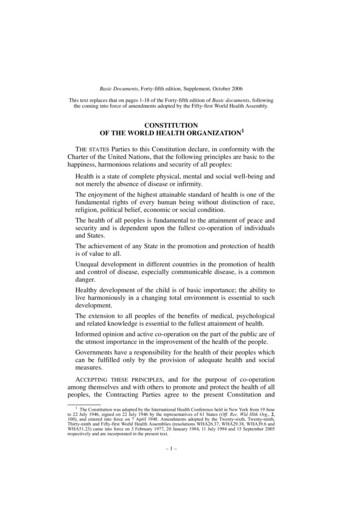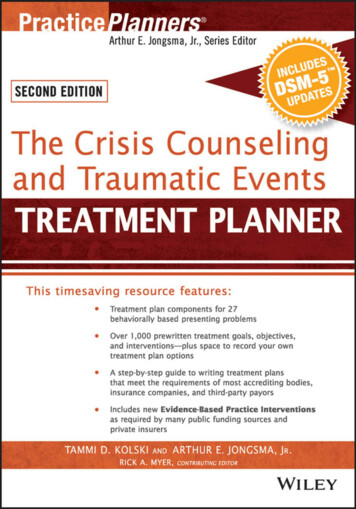
Transcription
2006 annual report1961 forty-fifth anniversary 2006
co n t e n t s2 L etter from the President/CEO& Vice President for Program3 Letter from the Chair of the Boardcelebrate4 The African Heartlands8 Landscape Conservation14 Species Conservation20 Conservation Enterprisethe most spectacular wildlife on earth,26 Conservation Leadership32 Shaping Policy34 Conservation Partnersthe vast landscapes that sustain them,36 Public Education & Outreach38 Campaign for the African Heartlands40 Financial Resources for Conservationand the people who aspire42 Funding & Financial Overview44 With Much Gratitude: AWF Donorsto fulfill the promise that isAWF helps found theWildlife Clubs of Kenyato educate youth aboutthe environment andconservation1978AWF unveils “Give a Liona Home” ad; proceedsused to enlarge twoAfrican parks1975AWF finances firstall-Swahili wildlifenewspaper, “UrithiWetu,” or “Our Heritage”AWF research grantfinances the SerengetiResearch Institute1970First class graduatesfrom the Collegeof African WildlifeManagement in Mweka1968AWF’s first project isto help establish theCollege of AfricanWildlife Management inMweka, Tanzania1967Washington Safari Club’sConservation Committeecreates the AfricanWildlife Foundation(originally calledthe African WildlifeLeadership Foundation)196519611962Front Cover Photo Credits: Dancers, Craig R. Sholley;Elephants, james Weis/www.eyesonafrica.net.africaAWF begins long-termsupport of CynthiaMoss’s ElephantResearch Project;population grows from400 to 1,000 elephantsin next 20 yearsAWF establishes theMountain Gorilla Projectin Rwanda to helpprotect gorillas
Patrick J. Bergin, Ph.D.Helen W. Gichohi, Ph.D.President & CEOVice President for ProgramAWF’s 45 years of leadership in African conservationis a remarkable achievement—but I’m convinced thatour greatest celebrations lie ahead. To that end, we areengaged in a comprehensive campaign that will allow usto bring significantly greater resources to bear.In our three-year campaign, we seek to raise 65million from individuals, corporations and private foundations—resources that will be enhanced by an additional 35 million in grants from governments over the same period of time.When successful, this campaign will raise a total of 100 million,enabling AWF to expand the conservation efforts by 50 percent.I can’t tell you how critical these funds are for AWF’s mission.A tremendous change is taking place in how conservation is done, andAWF is at the vanguard. We have learned what works, and in manyareas we lead the world. But we urgently need to do much more of it,in more places—because every year that we wait, it gets harder to do!I urge you to join me in supporting the African Wildlife Foundation’s fundraising campaign by contacting Gregg Mitchell, VicePresident for Development and Communications, in our Washington,D.C. office. I can’t think of any other way that your gift could bemore leveraged, and do more good for the survival of Africa’s wildlifeand the prosperity of its people.Dennis KellerAWF proposes the IvoryBan as an emergencymeasure to end elephantpoachingThe African elephantis elevated to “mostendangered” categoryby Convention onInternational Trade inEndangered Species(CITES)1996AWF launches“Save the Elephants”campaign, and1988 is designated the“Year of theElephant”19901989198819821985AWF beginscollaborating withTanzania National Parks(TANAPA) to developand apply principles ofcommunity conservationMr. Edward M. Armfield, Jr.Mr. Robin BerkeleyMrs. Wendy M. BreckMr. Jacques J. BusquetMr. Paul CampbellMr. Stephen D. CashinMr. Dale F. (Tucker) DornDr. James L. FoghtMs. Leila S. GreenMs. Christine F. HemrickMr. William S. KalemaMr. Walter KansteinerMr. Robert E. KingMr. Mark D. KvammeMr. James MakawaSir Ketumile MasireAnne B. Mize, Ph.D.Benjamin W. MkapaMrs. Eleanor G. NalleDr. Mamphela A. RampheleMs. Tia N. RoddyMr. Paul A. SchosbergMs. Lisa M. StevensMr. David ThomsonMr. C. Bowdoin TrainMr. John WalterMr. Richard Weening TRUSTEE EMERITIMr. Arthur W. ArundelMr. E. U. Curtis BohlenDr. David ChallinorMrs. Joan DonnerMr. John H. HeminwayMr. George C. HixonMr. Richard M. JacksonMr. Henry P. McIntosh IVMrs. Sally PingreeMr. Stuart T. Saunders, Jr.Mr. Russell E. TrainChair, Board of TrusteesNorth Yemen barslegal import of rhinohorns after diplomaticintervention by AWF andpartnersMr. Dennis J. Keller, ChairMr. Matthew T. Weir, Vice ChairMs. Wariara Mbugua, SecretaryMrs. Crandall C. Bowles,Treasurer1998It’s late on a Friday afternoon. Soon the sun will touchthe tops of the trees forming a canopy above ourheads. The two of us are in a huge canoe hewn fromthe trunk of a single massive tree, traveling slowly downone of the large, broad tributaries of the Congo River. Wehave been out of cell phone range for some time now. Ourminds are cleared of external distractions.As the trees and villages go by, we are deep in conversation, taking stock, reflecting on the last five years. We each took up our present posts duringthe celebration of AWF’s 40th anniversary. Time has gone by quickly. What have we achieved?We believe that we have re-engineered AWF into an organization much more likely todeliver on the ambitious mission of ensuring a future for Africa’s wildlife and wild lands.We believe we have found ways to live much more fully AWF’s core values of being a trulyAfrica-driven organization, and of being an organization that has always seen the well-being ofAfrica’s people as an inseparable part of its mission.We believe we have designed and rolled out a well-conceived and scientifically-basedconservation program in the African Heartlands that can create an enduring future for wildlifein places where it would otherwise surely be lost.We feel good about what has been achieved, but we have not delivered the real prize yet.Our challenge is to focus on those bold priority actions that will determine the fate of thesegreat conservation landscapes.Many of you, our partners and supporters, have been with us on this journey and we wouldlike to thank you immensely. There is plenty of room in the canoe that is AWF—and we inviteyou to continue to travel with us as we pursue our mission to conserve Africa’s great Heartlands.board oftrusteesInternational Gorilla ConservationProgramme (IGCP) is launched by AWF,Fauna and Flora International and the WorldWide Fund for NatureThe Charlotte Conservation FellowshipProgram honoring Charlotte Kidder Ramseyis established to help develop conservationleaders through advanced trainingAWF starts its Neighbours as PartnersProgram which pioneered communityconservation around national parks in Eastand Central AfricaIn the face of civil war in Rwanda, many aidworkers depart—but IGCP personnel remainto protect Virunga’s mountain gorillas; nogorillas are killed in 1996 and at least ninebabies are bornAWF marks a new erain African conservationwith its AfricanHeartlands Program toprotect large landscapesof exceptional naturalvalue
Tanzania’s PresidentMkapa declares that theManyara Ranch will beprotected as a wildlifecorridor and gives theranch to the TanzaniaLand Conservation TrustAWF identifies the newCongo heartland in theDemocratic Republicof Congo, brighteningthe future of speciesincluding the bonoboand Congo peacockAWF Large CarnivoreResearch Projectfocuses on lions and thespotted hyenaNew world-class VisitorCenters open at LakeManyara National Parkand Tarangire NationalPark, TanzaniaThe mountain gorillapopulation in theVirunga Volcanoes growsby 56, or 17%, since1989—in spite of civilunrest and poaching2006Dr. Patrick J. Bergin isappointed to the positionof President and ChiefExecutive Officer of AWFand supporters who have been part of this remarkable story, we sendour thanks. There would be nothing to celebrate without you.2005AWF’s work expands intosouthern Africa withthe implementationof African HeartlandsProgram in Zimbabwe,South Africa, Zambiaand Botswana2003Partnership Optionsfor Resource-UseInnovation (PORI),a USAID-supportedproject designed to helpdevelop communitybased wildlifeenterprises in northernTanzania, becomes thefirst African Heartlandeffort200119992000 scapes are absolutely essential to conservation—thanks to theirunmatched concentrations of wildlife, and their potential tosustain viable populations for centuries to come.AWF has identified these landscapes, and we call them the“African Heartlands.”Far larger than any park or reserve, an African Heartlandcombines national parks and local villages, government lands andprivate lands into a large, cohesive conservation landscape thatoften spans international boundaries.In an African Heartland, 45 years of conservation leadershipreach their highest expression. To all the scientists, strategists, partners2004It’s no wonder the world loves to celebrate Africa. We allcarry a piece of Africa in our hearts.Africa was the first place on earth where human beingstold stories by firelight and lifted their voices in song. It is thelast place where megafauna roam in vast herds across unfetteredlandscapes.But while all of Africa is extraordinary, certain key land- james Weis/www.eyesonafrica.netthe african h eartlands Craig R. Sholley Craig R. Sholley Craig R. Sholley james Weis/www.eyesonafrica.net Mark Boulton Craig R. Sholley John Watkins/ICCE1.0713 African wild dog research is in full swingin the Samburu Heartland, KenyaUganda’s Mgahinga Gorilla National Parkopens new Vistor CenterAWF partners with Starbucks to link bettercoffee quality and improved livelihoods forgrowers with natural resource conservationin east AfricaCongo Shipping Project makes first voyageup and down the Congo and MaringaRivers, opening up markets for remotevillages and encouraging conservationfriendly agricultureAWF partners with the Mozambicangovernment to restore the magnificentBanhine National Park
the african h eartlandsC ong o H e art lan dMaas a i St e p p e H e art lan dDemocratic Republic of CongoTanzaniaLa n dsca pe:TUNISIAMOROCCOLocated in the center of the Congo Basin,this Heartland is a globally significant area of intactrainforest.Nilecorridors, dispersal areas and breeding grounds.Botswana, Namibia, Zambia, ZimbabweTarget Speci es:where river systems and wetlands eventually give wayERITREACHADGAMBIAGUINEA BISSAUerNigR.SIERRA OGHANACENTRALAFRICAN REPUBLICLIBERIAETHIOPIACAMEROONCongoEQUATORIAL ENYAKampalaNanyukiNairobiRWANDADEMOCRATICREPUBLIC OF CONGOSamburuNamangaBURUNDIArushaKilimanjaroMaasai SteppeKinshasaMALAWIANGOLALusakaKaribaZambez iKasaneKazungulaLivingstoneZIMBABWEMOZAMBIQUER.AWF Conservation CenterMassingirLimpopoWhiteRiverAWF Program CountryMajor Lake/RiverMADAGASCARBOTSWANAAfrican HeartlandsCountry BoundaryS a m b u ru H e art lan dmigration corridors.SWAZILANDOr LESOTHOangeR.SOUTH AFRICALargest concentration of elephant inLa n dsca pe:Located just north of the equator in theAfrica; lion, cheetah, giraffe, hippopotamus, rhinoceros,rain-shadow of Mt. Kenya, this Heartland marks theleopard; many species of antelope, goliath heron, breamnorthernmost point of AWF’s work—and is home toand tigerfish; many medicinal and endemic plant species.intact wet montane forests, dry cedar forests, plateaugrassland, acacia grassland and the Eswaso NyiroK i l i man jaro H e art lan dKenya, TanzaniaLa n dsca pe:Africa’s highest peak and most famousRiver—along with parts of Mt. Kenya National Park,Samburu National Reserve and extensive ranch andcommunal lands.Northern specialist species likelandmark rises in the center of this scenic Heartland—Target Speci es:surrounded by a variety of ecosystems from wetlands toreticulated giraffe, Somali ostrich, and Grevy’s zebra livesemi-arid savannah. Here, you’ll find Kenya’s Amboselialongside elephant, lion, hyena, leopard and black rhino.National Park, Tanzania’s Kilimanjaro and ArushaNational Parks, and vast community lands tended byV i rung a H e art lan dthe Maasai people.Democratic Republic of Congo, Rwanda, UgandaAfrica’s best-known and most-studiedLa n dsca pe:Virunga volcanic highlands and theelephant population; the endangered cheetah and wildBwindi Impenetrable Forest National Park highlightdog; declining tree species of juniper and ebony.a region of incredible biodiversity that spans parts ofL i m p op o H e art lan dTarget Speci es:Mozambique, South Africa, ZimbabweLa n dsca pe:This vast Heartland covers areas ofMozambique, South Africa and Zimbabwe. CenteredAWF Field OfficeNAMIBIAungulates like fringe-eared oryx, kudu and gerenuk.Democratic Republic of Congo, Rwanda and Uganda.ZambeziZAMBIAcheetah and wild dog; elephant; and locally endangeredKenyaTarget Speci es:TANZANIALarge predators like lion, leopard,to a woodland-grassland mosaic with vital wildlifeTarget Speci es:BURKINAFASOGUINEAOne of the world’s greatest cataracts—Victoria Falls—is the crown jewel in this vast landscapeR.NIGERSENEGALNational Park, in particular, is recognized internationallyKaz ung u l a H e art lan dLa n dsca pe:MALIzania’s most frequented national parks. Lake Manyaraas a Biosphere Reserve and includes key migrationEGYPTWESTERNSAHARAMAURITANIAThe exotic and endangered bonobo,Congo peacock and forest elephant.LIBYAA mosaic of baobab and acacia treesscattered across vast savannah, this is one of the world’srichest remaining reserves for wildlife—with two of Tan-Target Speci es:ALGERIALa n dsca pe:The last 700 mountain gorillas in theworld, along with chimpanzee, golden monkey, giantforest hog, African buffalo and rich birdlife.on the Limpopo River, it includes world-famous KrugerZam b e z i H e art lan dNational Park.Mozambique, Zambia, ZimbabweTarget Speci es:Africa’s largest rhino population,La n dsca pe:This three-country, transboundary regionalong with rare ungulates, predators, hippopotamuses;of Zimbabwe, Zambia and Mozambique offers some ofrich birdlife, insects and diverse aquatic life.the most breathtaking landscapes in southern Africa,featuring the mighty Zambezi River and its surrounding1000 KmN1000 Mitributaries, wetlands and flood plains.Target Speci es:Hippopotamus, elephant, buffalo,impala, sable and roan antelope; eland, nyala, crocodile,black rhinoceros, wild dog, cheetah and lion.
l a n d s c a p eco ns ervat ionPutting the LandscapePuzzle Back Togetherin Maasai SteppeI Craig R. Sholleyn the five years since our40th anniversary, AWF’sAfrican Heartlands strategyhas come into its own—andwe have learned a great dealabout large-scale landscapeconservation.Nowhere is that progressmore evident than in the 22,223square kilometer Heartland wecall the Maasai Steppe. Herein the vast plains of northernTanzania, where elephants andtraditional Maasai tribespeoplelive side by side, AWF and ourpartners have created a successstory that is now the model forcelebra teLoss of habitat is the single largest threat facing wildlife in Africa—and this realizationis the inspiration behind the African Heartlands Program. Most of the land in theAfrican Heartlands can be classified as state, community or private; and AWF worksto address all three categories. We support parks and reserves; help community groupsContinued on page 10 protect special sites like corridors and springs; and create private land conservationtrusts with the power to purchase land outright. Together with our partners, we areputting fragmented landscapes back together. We are giving wildlife the room theyneed to move, to propagate and to thrive.
l a n d s c a p eco ns ervat ionnew landscape initiatives throughout theAfrican Heartlands. AWF/Paul Thomson10Imagine you were an elephantliving in that area five yearsago. You may have enteredthe Maasai Steppe Heartland on your seasonalmovement from the worldfamous Ngorongoro Crater.Your first stop would probablyhave been for a roll in the mud ora cool drink from the waters in LakeManyara National Park, a world BiosphereReserve. From there, your herd may havetried to move to the equally famous and farlarger Tarangire National Park just to thesoutheast—but you probably would not havemade it. For between those two parks was40 kms of unprotected land; land that wasfilling up with more farms and developmentevery day.That, in a nutshell, is the challenge AWFfaces in the Maasai Steppe and in so many Craig R. SholleyIslands of Isolationother Heartlands: a vast, wildlife-rich region,anchored by national parks, that is becomingincreasingly fragmented—leading to unnatural isolation of wildlife in eversmaller “islands” of biodiversitythat does not allow for migration and inter-breeding.But that was five yearsago. Today, you would findthe journey from NgorongoroCrater all the way to thesouthern tip of TarangireNational Park neither difficultnor impeded. That is a hugeaccomplishment—and a tribute to longyears of hard work in the Maasai Steppe.The First Step in Maasai Steppe:Supporting Protected AreasNational parks are still the single largest landunits in any Heartland. They are the placewhere any landscape strategy must begin.In the Maasai Steppe, Lake Manyara andTarangire National Parks are key not just tolandscape conservation but to Tanzania’s touristeconomy—generating a substantial proportionHelping Samburu Rangers Feel at HomeThe warden and rangers of the Samburu National Reserve had dedication.They had enthusiasm. What they didn’t have was training, tools—or a roofover their heads that didn’t leak. That’s why AWF has made a major investmentin the Reserve’s infrastructure. It began with renovation of rangers’ houses atthe eastern gate of the reserve. And it culminated this year with the completionof houses at the western gate and at reserve headquarters for the wardens, therangers and their families.Along the way, AWF has also created road signage, provided hand-held radios,rehabilitated the water supply to rangers’ houses, and even helped to marketthe Samburu Reserve at the World Travel Market in London. For AWF staff, thehigh point of this effort was the outpouring of appreciation. In the words ofMr. Abdi Boru, Senior Warden: “To the entire AWF family we have no words toexpress our asante to you for all the support you have given us. Please, please,keep up the excellent work.” And that is exactly what we intend to do.of the nation’s gross domestic product. Yet whenAWF first became involved with these parkstwenty years ago, they lacked many of the basicsof park management and infrastructure.In partnership with USAID and TANAPA(Tanzania National Parks), AWF has implementeda comprehensive support plan for both parks.AWF got things rolling in 1998, by providingvehicles to improve overall capacity for parkmanagement and anti-poaching patrols. And in2000, we improved the condition of the roadsby giving TANAPA a bulldozer, road grader,compactor and backhoe-wheel loader.Of course, communications are as importantas any roadway to running a park. Yet whenAWF first got involved, Lake Manyara NationalPark did not even have telephones. Today, bothparks have phones, hand-held radios and vehiclemounted VHF radios, not to mention laptopcomputers, printers and Internet communication.When park staff head home after a busy day,many of them go to new housing with a reliablewater supply—something that simply did notexist five years ago. AWF has also helped theparks reach out to the world by creating guidebooks, marketing materials and two world-classVisitor Centers.But infrastructure was just the beginning. Incollaboration with the U.S. Department of Interiorand USAID, AWF has conducted training coursesfor staff in road maintenance, anti-poachingoperations and fire management. And made sureboth parks are professionally administered withcomprehensive General Management Plans. Asa result, combined park revenues increased from 2.7 million in 1998 to 3.2 million in 2005—an increase of 19 percent.Today, the two parks’ future as mainstaysof Tanzania’s tourist economy is assured. Andthe twin anchors of the Maasai Steppe landscapeare secure.Continued on page 12 james Weis/www.eyesonafrica.netContinued from page 10Restoring Wetlands byRebuilding a National ParkThe prime source of water in a veryarid region, Banhine National Parkis renowned for its wetlands and itssmall population of endangered wattledcranes. The potential to develop this parkto international standards is very highbecause there are very few people livingin and around it. But in reality, Banhineis a “paper park”—it has no infrastructure,no management, no enforcement.In other words, the park must be rebuiltfrom scratch.When Mozambique’s Ministry ofTourism received a 5.1 million credit fromthe World Bank to rehabilitate Banhine,they called on AWF to help—in large partbecause AWF already has an importantpresence in Banhine, having alreadyimplemented everything from aerialsurveys to a research center.The hard work of rehabilitatingBanhine will involve everything frombuilding infrastructure, acquiring equipmentand training staff to redesigning the park’sboundaries to provide a better balance ofbiomes. With these problems being addressed,Banhine National Park will soon be back onthe map—and back on the list of Africa’s“must-see” wildlife destinations.11
l a n d s c a p eco ns ervat ionSatellites Help AWF Get the Big PictureWhen you look out across the forest floor in theCongo Heartland, the trees seem endless anddestined to live forever. But if youcould look down from earth orbit,you would see countless patchesof smoke where farmers are trying to grow maize on poor forestsoil. And you would see a growing network of roads and pathsspreading like spider webs throughthe jungle, plied by people movingever deeper into the forest.But knowledge is power, andimages of large fires detected from space on a map of theCongo Heartland. The images illustrate precisely whichforest areas have been destroyedsince the 1990s—graphically depicting a decade of change in thelandscape, and the growing threatto the bonobo and the thousandsof others species that call theCongo Basin home.Thanks to these maps, wenow have a powerful, new tool foridentifying key threats—and wecan generate sustainable develop-what you can measure, you can deal with. That’s why NASA,the University of Maryland and USAID are helping AWFmonitor the state of these forests by overlaying satellitement options that will be more effective in improving thelives of people in the area while protecting the forest andthe animals that live there.Continued from page 1112Step Two: The Tanzania LandConservation TrustEven with protected areas thriving, the problemsof linking them and securing other ecologicallyimportant areas remain. Lake Manyara NationalPark and Tarangire National Park are 40 kmapart. About ten years ago, the migration routethat connects them—known as the Kwakuchinjacorridor—began to disappear.Historically, the Maasai Steppe has beenhome to Maasai people. Today, some 350,000Maasai herd a million cattle in a pastoral lifestyle that has changed little in a thousand years.And for a thousand years, livestock and wildlifehave mixed freely on the Maasai range.In the last decade, however, new ethnicgroups have moved onto Maasai lands—shrinking grazing areas and putting pressureon the Maasai to turn to subsistence farming.As a result, the Kwakuchinja corridor has narrowed—in some places to just four km wide.To protect corridors like Kwakuchinja, itwas obvious that AWF had to find non-gov-ernmental, community-based approaches to setland aside for conservation. AWF helped createthe Tanzania Land Conservation Trust—one ofthe first of its kind in the nation.Through a land trust, stakeholders—inthis case, a combination of government, community groups and AWF—can buy and sellproperty with the freedom of a private owner.The TLCT’s first action was to secure a prime44,000 acre ranch that lies squarely in theKwakuchinja migration corridor.A few years ago, the National RanchingCompany of Tanzania (NARCO) managed14 ranches on the government’s behalf, untilsweeping new reforms required them to divestthese non-performing assets. Thirteen of theranches are now undergoing different formsof privatization—but Manyara Ranch becamean AWF conservation success story.Today, Manyara Ranch successfullymanages cattle in conservation-friendly ways.Rangers patrol the ranch, monitoring wildlifeand warding off poachers. And with the helpof the Annenberg Foundation and others, apre-existing boarding school for Maasai children willbe moved out of the wildlife’s way—relocated to anultramodern facility due to be completed towards theend of this year. But most important, a huge portion ofthe Kwakuchinja corridor is secured for the future.Step Three: Opening Corridors andDisperal Areas, Engaging CommunitiesWhile Manyara Ranch fills a substantial part of thecorridor, much land remains unprotected. So AWF hasalso been working to help local communities conserveland in wildlife-friendly ways.A few years ago, for example, the Tanzaniangovernment authorized the creation of WildlifeManagement Areas, or WMAs—community-runorganizations that allow the people to reap the benefits of managing their own lands (most of the revenuefrom hunting permits, for example, used to go tothe government. In a WMA, most of it goes to thecommunity.) After a thorough education process invillages throughout the Maasai Steppe, AWF is proudto announce the inauguration of the Burunge WMA—among the first in the nation. And one that lies in theheart of the Kwakuchinja corridor.Along with WMAs, AWF is engaging communities through a program called KEEP (The KwakuchinjaEasements for the Environment Through PartnershipProject). KEEP is working to “keep” the corridor openby securing small parcels of land—usually farmingplots—any way it can: through outright purchase (bythe Tanzania Land Conservation Trust), by negotiatingeasements, and by assisting communities with conversation enterprises and infrastructure development.Through all three strategies—supporting protectedareas, engaging communities and acquiring land throughthe TLCT—AWF has spent the last decade pullingtogether the Maasai Steppe landscape. And while muchwork remains—especially in the vital Simanjiro plains—it is our vision that ten years from now, other Heartlandswill enjoy the same network of linked conservationareas.Replanting a Forest,Restoring the FutureSpreading across 762 hectares, theLoitokitok forest once covered theslopes of Mount Kilimanjaro with a seaof green. But today, almost half of it isbare—due to years of deforestation byfarmers as part of the Forest Department’sfailed “Shamba” System. (Under Shamba,farmers were allowed to clear trees so longas they replanted trees for timber—butthe re-planting never occurred.)Not only is Loitokitok forest critical habitat for wildlife—including fivegroups of black-white colobus monkeys—but it protects a crucial watershedfor springs flowing from Kilimanjaro tothe Amboseli and Kuku plains. We areexcited to report that from January 2005to January 2006, in partnership with theU.S. Forest Service, AWF worked withfour village groups to plant 41,500 trees(10,000 more were planted by Kenya’sForest Department). Along with restoringforest cover, AWF is building a partnership between the community and theKenya Forest Department—promotingthe new forest management law whichempowers local communities.Each village group is taking careof their trees as part of an agreementwhere AWF compensated them for everytree planted—and protected—for a sixmonth period. As a result, in spite ofdrought, more than half the seedlingshave survived. All the dead seedlingshave been re-planted. Communityparticipation in forest management hasbeen improved. And a brighter future forthe wildlife and people is taking root.13
species conse rvationElephant Research:Pure Science,Practical ImpactP Craig R. Sholleyerhaps more than anyother species, elephantsput AWF’s landscapelevel approach to the test. Theirhuge appetites drive them totravel far outside national parks.Their incredible size and forcebring them into dangerousconflict with humans.AWF has long recognizedthat the key to protectingwildlife corridors and reducingconflict is knowledge—andknowledge comes from research.The more we know about why,when and where elephants go,the more we can develop celebra tewildlifeContinued on page 16If it is to survive, Africa’s wildlife must be one with the land—free to fulfill its naturalrole in its ecosystem. So while AWF helps protect endangered species with everything fromanti-poaching patrols to securing rhinoceros sanctuaries, we go beyond individual tactics topursue a strategic vision for the habitat as a whole. On the one hand, we support up-and-coming, high-caliber African research scientists. On the other hand, we develop practical,problem-solving interventions. Because both are part of our larger African HeartlandsProgram, the usual gap between “research” and “application” is bridged. And researchfindings are quickly translated into the one thing that matters most: action.15
species conse rvationAnthrax Attack: The LatestChallenge for Grevy’s Zebraconservation strategies that work. That’s whywe sponsor the education of up-and-comingAfrican scientists, and support their researchprojects. And that’s how we got to knowTanzania’s Alfred Kikoti.OAlfred Kikoti wasborn to work withelephants. As a childhe loved to visit thenational parks and pretend he was a ranger on theprowl for poachers. A decadelater, he befriended a young Peace Corpsvolunteer who urged him to follow his dreamsand attend the College of African WildlifeManagement at Mweka, Tanzania. Thatvolunteer was Patrick Bergin, who went onto become the President of AWF—and Alfredwent on to become AWF’s leading elephantresearcher.After a few years as a park warden, Alfredcame to believe he could accomplish evenmore outside the parks, where wildlife mustshare the land with people. AWF then sponsoredhis Master’s degree studies in Wales, UnitedKingdom. And Alfred Kikoti has been conductin
National Parks, and vast community lands tended by the Maasai people. TargeT species: Africa's best-known and most-studied elephant population; the endangered cheetah and wild dog; declining tree species of juniper and ebony. limpopo Heartland Mozambique, South Africa, Zimbabwe Landscape: This vast Heartland covers areas of
